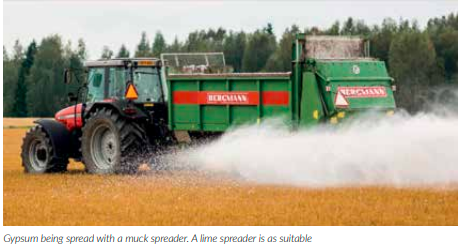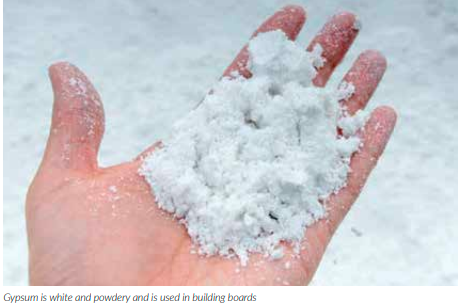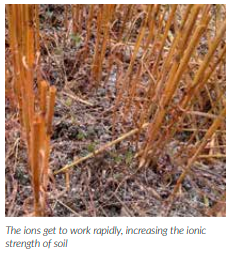Editor Mike Donovan interprets a vital study on soil run-off from Finland
Nutrient and soil run-off to water courses is a major concern in Finland, with land in the southwest of major concern. For more than 20 years farmers in the region have been involved in many efforts to reduce the problem. These have included the use of buffer strips which will physically hold back run-off and encourage the water to soak away. Fertiliser restrictions have been another measure, but all have not been sufficiently effective, particularly in the aim of lowering the phosphorous load.
Farmers have known the positive effects of gypsum on soil condition for more than 100 years and for the past ten years there has been considerable interest and research done to find out how well gypsum prevents mineral leaching, especially phosphorus. The product is widely available in Finland as an industrial by-product from the phosphoric acid industry from Siilinjärvi. Gypsum is formed when locally mined apatite is dissolved in sulphuric acid. Because apatite from Siilinjärvi contains no heavy metals or radioactivity, the gypsum generated by its process is safe to use. The leaching of phosphorus is strongest from fields susceptible to erosion, or those that have abundant phosphorus reserves. Such fields can be found in the river basin of the Archipelago Sea.
Adding gypsum as a water protection measure is simple and feasible for large-scale use. It supports the official goals and targets for reducing phosphorus leaching and accelerates their achievement. Gypsum has a direct impact on leaching, which improves the state of coastal waters. As a non-productive investment, it is also eligible for support through agricultural subsidy programmes.
The trial concluded that applying gypsum to the land reduced phosphate and other leaching immediately and at low cost. No adverse effects were detected.
Spreading uses farm equipment
Gypsum is easy to apply to the soil using a lime or manure spreader. 4 t/ ha of gypsum will achieve results in controlling leaching. Gypsum can be spread on stubble fields in the autumn if the farmer is planning notill sowing in the spring. No-till sowing should not be carried out directly after gypsum spreading, because the ionic strength of the fields surface may temporarily rise to a level that hampers germination. Gypsum should be spread during a dry period, and it’s best not to plan to store it for a long period and it will settle into lumps which reduce spreading accuracy. It can be stored at the side of the field, but needs to be covered by a tarpaulin. This will prevent it being blown and also stop the surface from going hard.
Gypsum appears to be active for around five years, and the project is monitoring the river conditions for almost that time.
The effects on water quality
The Finnish investigation is covering 1,500 hectares in a research area totalling 82km2, of which 43% arable land. The control area is in one block upstream of the test area. There is woodland, houses and fields which are cultivated in many different ways.
The sulphate content of gypsum was considered a key risk factor in the use of gypsum as a soil enhancer and a way of reducing run-off. Sulphate is a naturally occurring substance that is abundant in sea water, for example. Being highly soluble, it also leaches off fields over a period of years. After gypsum spreading, the Savijoki river had an average sulphate content of 32 mg/l compared to 11 mg/l before spreading. In the first rains after spreading, sulphate concentrations briefly rose to 320 mg/l, but did not exceed 100 mg/l at any time thereafter.
They found that the measured sulphate concentrations were found to have no adverse effect on the behaviour or occurrence of adult thickshelled river mussels, or the survival of their larvae. Neither was any effect observed on fish stocks (including the reproduction of trout) or in the growth of antifever fontinalis moss. Further findings on the effects of gypsum amendment on trout reproduction will be obtained after another gypsum spreading project in the Vantaanjoki river.
Could gypsum end up in groundwater?
Because the sulphate and calcium contained in gypsum easily runs off with water, it can end up in groundwater after being filtered through the soil strata. Gypsum is not therefore recommended for use in areas where groundwater is collected in underground aquifers, although moderate concentrations of sulphate or calcium are not detrimental to humans or infrastructure. Samples were taken from seven wells located close to the gypsum-treated plots in the Savijoki pilot area. There was no change in the sulphate or calcium levels of the well water, apart from one well where it was found that surface water had gone directly into the well from the surface of the field. This well also showed a significant increase in nitrate, which is not contained in gypsum.
Monitoring of soil and crops
The project monitored crops and the soil on 30 plots before and after gypsum spreading. Basic tests and microbial activity evaluations were carried out on soil samples, and Eurofins’ extensive plant and selenium analyses were made on crop samples. In addition, the farmers in the area were asked for supplementary observations. Gypsum dissolves rapidly in soil, which was reflected in higher sulphur concentrations and conductivity values in a fertility analysis carried out during the summer following the gypsum spreading. Sulphate binds weakly to soil, as shown by the clear reduction in sulphur levels in a soil analysis in the following year. Some calcium from the gypsum remains in the cation exchange sites, displacing the magnesium and other cations from the particle surfaces.
Gypsum appears to have no adverse effect on the availability of soil phosphorus for plants, and no changes were observed in phosphorus concentrations in crops.
Sulphate in gypsum has been found to impair the absorption of selenium by plants during the first year after gypsum spreading, something to be aware of if the crops are used as animal feed. However, no declines in selenium were observed in the Savijoki river research, and levels are generally low in the region. It has also been suggested that gypsum reduces the absorption of boron, but no support has been found for this claim. The sulphur content of the crop rose in the gypsum-treated plots.
Where can gypsum be used?
Gypsum is particularly suitable for reducing phosphorus runoff on clay soils and the benefits will be best gained by regional targeting. Around 540,000 hectares of the drainage basins of the Bothnian Sea, Archipelago Sea and Gulf of Finland – or around a quarter of Finland’s entire arable area – are potentially suitable for the spreading of gypsum. Organic farming is being carried out on around 10% of the suitable arable area.The potential area excludes the areas where gypsum application is not recommended due to the sulphate content of gypsum.

Sulphate is not harmful after entering the sea, since sea water is naturally rich in sulphate. On the other hand, in lake-basin areas gypsum should not be used until information can be gained on how strongly sulphate runoff affects the sulphur content of lakebed water, particularly those with slow water exchange. A rise in sulphate levels could increase the release of phosphorus from lakebed sediments and accelerate eutrophication. In addition, gypsum is not recommended for use in or near nature reserves. In groundwater areas, careful consideration should be given to the use of gypsum, in the same way as it is for slurry spreading. Furthermore, gypsum is not recommended for use in acidic sulphate soils either, where it has only a negligible eosphorus.
Issues that must be accounted for by farmers
According to the EU organic farming regulation, natural gypsum can be used in organic farming but industrially produced gypsum (such as Siilinjärvi gypsum) cannot. Gypsum is not recommended for use in fields that have a deficiency of potassium or magnesium and are correspondingly rich in calcium. The addition of calcium displaces potassium and magnesium from the surfaces of soil particles, highlighting the imbalance between their various cations. Gypsum does not affect the acidity of arable land. If there is an acidity problem in a field it is recommended to be treated with lime before using gypsum as a means of water protection.
If a well is located in the gypsum spreading area a zone should be left around the well. Gypsum produced as a by-product of the phosphoric acid industry contains a small amount of phosphorus (e.g. 0.2% in Siilinjärvi gypsum). The farmer may choose to take this into account when determining the amount of phosphorus fertilisation. However, the fertiliser restrictions associated with environmental compensation take no account of the amount of phosphorus contained in gypsum.
Gypsum has the potential to reduce phosphorous in the Baltic
The use of gypsum on arable land has the potential to reduce the inflow of phosphorous by some 300 tonnes a year. This action would help achieve the phosphorus reduction targets set by the HELCOM Baltic Sea Action Plan and the Finnish Marine Strategy. If gypsum amendment were also introduced in Sweden, Denmark and Poland, for example, an annual reduction of 1,500 to 2,000 tonnes would be achieved. In the long term the gypsum would begin to improve the condition of the entire Baltic Sea.
Adding gypsum to current soil run-off plans
Attempts have been made to reduce agricultural phosphorus leaching in Finland by preventing the runoff of solid matter and limiting the amount of phosphorus fertilisation in fields which have higher phosphorus levels. However, phosphorus leaching from fields with high phosphorus levels only reduces in the long run, when excess phosphorus is removed from the soil along with the crop. On the other hand, stepping up anti-erosion activities is costly. With gypsum applications a reduction in phosphorus runoff can be achieved faster and more costeffectively than with current methods.

Stepping up anti-erosion activities is costly. With gypsum treatment, a result can be achieved faster and at less cost. The costs of gypsum amendment have been ascertained in the Savijoki river pilot and earlier projects, all of which involved the use of Siilinjärvi gypsum. The total cost of the process was around EUR 220 per hectare, with haulage from Siilinjärvi to the farms accounted for about 60% of the cost. The remainder is divided between the material and the costs incurred at the farm.
What the farmers think
If gypsum amendment were covered by the agricultural support scheme, most farmers who participated in the Savijoki river pilot project thought that they would use the scheme. The experiment was positive for many of them and they would be ready to recommend the use of gypsum to others. The survey indicated that none of the farmers experienced reduced crop yields or adverse soil conditions due to the gypsum. Individual farmers found the effect on yields was positive, but most said the effect was neutral. Improved soil condition was reported by farmers who either ploughed or light-tilled their fields – about 30% thought it had a positive effect on the soil. A few no-till farmers also believed there was some improvement. Compaction and ruts from spreading work was noted by 25%, but others experienced no problems at all.

A total of 55 farmers were involved in a gypsum-spreading pilot carried out in the Savijoki river basin in Lieto and Paimio in the autumn of 2016. The farmers ordered the gypsum through an agricultural retailer. Most of the spreading (80% of the farms) was done through a contractor, and the rest with the farms’ own equipment. After the gypsum was spread, 58% of the fields were subject to light tilling, 33% were ploughed and 9% were left untilled.
Nine out of ten of the farmers estimate that the different stages of gypsum amendment – delivery, gypsum storage and transport around the farm, and spreading – went well. More than 70% considered the method well suitable for use between other farm works at field. On individual farms, difficulties arose due to the capacity of the related fields, laterthan-expected threshing, and windy weather. The success of the largescale pilot was promoted by long spells of dry and fair weather in the autumn of 2016. The experiences of farmers were gathered through surveys and joint events between 2016 and 2017.
Science backs up practice
Erkki Aura began to study the impact of gypsum on clay erosion in the early 2000s. His experiments were followed by Kemira GrowHow’s laboratory tests and the TraP project in 2007– 2010, in which Nurmijärvi did rain simulation tests were carried out in a laboratory and a 100-hectare pilot. The effects were monitored by the TraP Follow up project. At the same time, the implementation of gypsum amendment was tested alongside farmers in the TarVeKe project. The TEHO project involved examining the impact of gypsum addition on soil characteristics, and investigating the spreadability of gypsum. In gypsum pilots performed for the SAVE and NutriTrade projects, the suitability of gypsum amendment was tested for large-scale use. In 2018, a new gypsum spreading project began in the Vantaanjoki river basin in Uusimaa.
Projects and financiers
The SAVE Project (2016–2018) is fund by the Finnish Ministry of the Environment, and the NutriTrade project was funded by the EU Interreg Central Baltic (2015–2018). SAVE is part of the government’s key project for a circular economy. Organisations implementing the projects are University of Helsinki and the Finnish Environment Institute Partners: John Nurminen Foundation, Natural Resource Institute Finland, Yara, Baltic Sea Action Group, the agricultural producer associations MTK and SLC, Southwest Finland ELY Centre, Luode Consulting, LounaisSuomen vesiensuojeluyhdistys, University of Jyväskylä, Turku University of Applied Sciences, Nixplore, ProAgria and Eurofins.